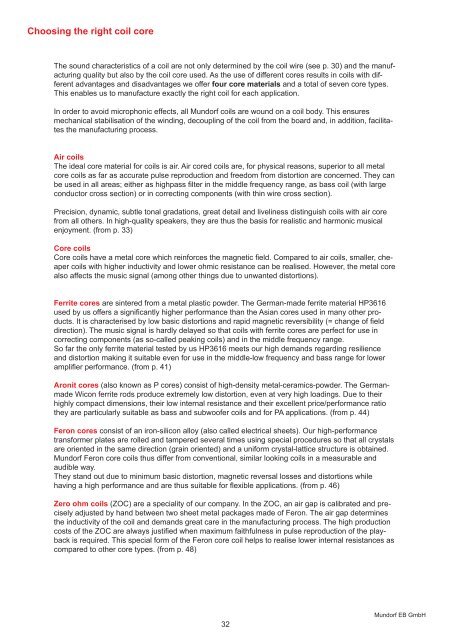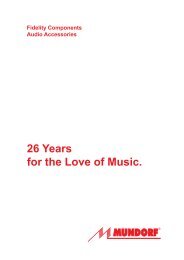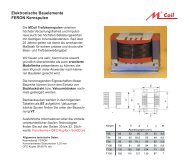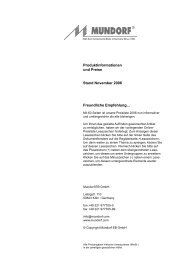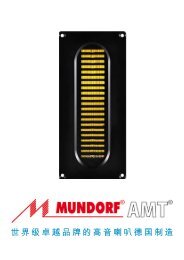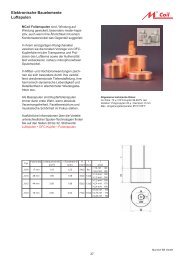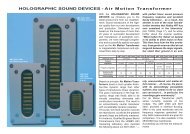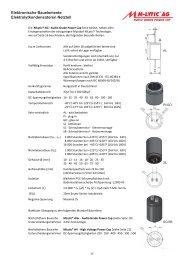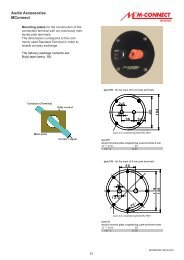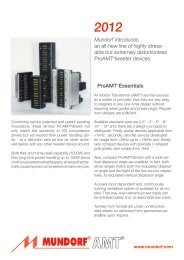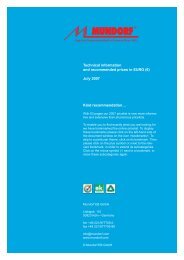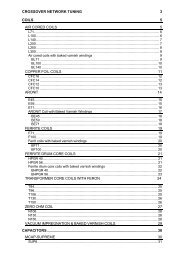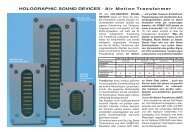26 Years for the Love of Music. Fidelity ... - Mundorf EB GmbH
26 Years for the Love of Music. Fidelity ... - Mundorf EB GmbH
26 Years for the Love of Music. Fidelity ... - Mundorf EB GmbH
You also want an ePaper? Increase the reach of your titles
YUMPU automatically turns print PDFs into web optimized ePapers that Google loves.
Choosing <strong>the</strong> right coil core<br />
The sound characteristics <strong>of</strong> a coil are not only determined by <strong>the</strong> coil wire (see p. 30) and <strong>the</strong> manufacturing<br />
quality but also by <strong>the</strong> coil core used. As <strong>the</strong> use <strong>of</strong> different cores results in coils with different<br />
advantages and disadvantages we <strong>of</strong>fer four core materials and a total <strong>of</strong> seven core types.<br />
This enables us to manufacture exactly <strong>the</strong> right coil <strong>for</strong> each application.<br />
In order to avoid microphonic effects, all <strong>Mundorf</strong> coils are wound on a coil body. This ensures<br />
mechanical stabilisation <strong>of</strong> <strong>the</strong> winding, decoupling <strong>of</strong> <strong>the</strong> coil from <strong>the</strong> board and, in addition, facilitates<br />
<strong>the</strong> manufacturing process.<br />
Air coils<br />
The ideal core material <strong>for</strong> coils is air. Air cored coils are, <strong>for</strong> physical reasons, superior to all metal<br />
core coils as far as accurate pulse reproduction and freedom from distortion are concerned. They can<br />
be used in all areas; ei<strong>the</strong>r as highpass fi lter in <strong>the</strong> middle frequency range, as bass coil (with large<br />
conductor cross section) or in correcting components (with thin wire cross section).<br />
Precision, dynamic, subtle tonal gradations, great detail and liveliness distinguish coils with air core<br />
from all o<strong>the</strong>rs. In high-quality speakers, <strong>the</strong>y are thus <strong>the</strong> basis <strong>for</strong> realistic and harmonic musical<br />
enjoyment. (from p. 33)<br />
Core coils<br />
Core coils have a metal core which rein<strong>for</strong>ces <strong>the</strong> magnetic fi eld. Compared to air coils, smaller, cheaper<br />
coils with higher inductivity and lower ohmic resistance can be realised. However, <strong>the</strong> metal core<br />
also affects <strong>the</strong> music signal (among o<strong>the</strong>r things due to unwanted distortions).<br />
Ferrite cores are sintered from a metal plastic powder. The German-made ferrite material HP3616<br />
used by us <strong>of</strong>fers a signifi cantly higher per<strong>for</strong>mance than <strong>the</strong> Asian cores used in many o<strong>the</strong>r products.<br />
It is characterised by low basic distortions and rapid magnetic reversibility (= change <strong>of</strong> fi eld<br />
direction). The music signal is hardly delayed so that coils with ferrite cores are perfect <strong>for</strong> use in<br />
correcting components (as so-called peaking coils) and in <strong>the</strong> middle frequency range.<br />
So far <strong>the</strong> only ferrite material tested by us HP3616 meets our high demands regarding resilience<br />
and distortion making it suitable even <strong>for</strong> use in <strong>the</strong> middle-low frequency and bass range <strong>for</strong> lower<br />
amplifi er per<strong>for</strong>mance. (from p. 41)<br />
Aronit cores (also known as P cores) consist <strong>of</strong> high-density metal-ceramics-powder. The Germanmade<br />
Wicon ferrite rods produce extremely low distortion, even at very high loadings. Due to <strong>the</strong>ir<br />
highly compact dimensions, <strong>the</strong>ir low internal resistance and <strong>the</strong>ir excellent price/per<strong>for</strong>mance ratio<br />
<strong>the</strong>y are particularly suitable as bass and subwo<strong>of</strong>er coils and <strong>for</strong> PA applications. (from p. 44)<br />
Feron cores consist <strong>of</strong> an iron-silicon alloy (also called electrical sheets). Our high-per<strong>for</strong>mance<br />
trans<strong>for</strong>mer plates are rolled and tampered several times using special procedures so that all crystals<br />
are oriented in <strong>the</strong> same direction (grain oriented) and a uni<strong>for</strong>m crystal-lattice structure is obtained.<br />
<strong>Mundorf</strong> Feron core coils thus differ from conventional, similar looking coils in a measurable and<br />
audible way.<br />
They stand out due to minimum basic distortion, magnetic reversal losses and distortions while<br />
having a high per<strong>for</strong>mance and are thus suitable <strong>for</strong> fl exible applications. (from p. 46)<br />
Zero ohm coils (ZOC) are a speciality <strong>of</strong> our company. In <strong>the</strong> ZOC, an air gap is calibrated and precisely<br />
adjusted by hand between two sheet metal packages made <strong>of</strong> Feron. The air gap determines<br />
<strong>the</strong> inductivity <strong>of</strong> <strong>the</strong> coil and demands great care in <strong>the</strong> manufacturing process. The high production<br />
costs <strong>of</strong> <strong>the</strong> ZOC are always justifi ed when maximum faithfulness in pulse reproduction <strong>of</strong> <strong>the</strong> playback<br />
is required. This special <strong>for</strong>m <strong>of</strong> <strong>the</strong> Feron core coil helps to realise lower internal resistances as<br />
compared to o<strong>the</strong>r core types. (from p. 48)<br />
32<br />
<strong>Mundorf</strong> <strong>EB</strong> <strong>GmbH</strong>


